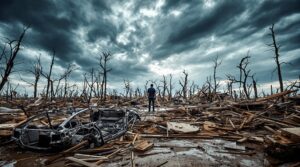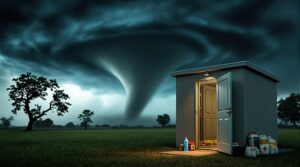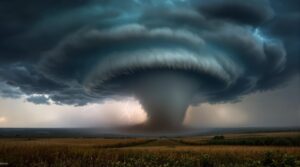EF3 tornadoes generate wind speeds of 136-165 mph, causing catastrophic structural damage and posing severe threats to life and property. These powerful storms have claimed 265 lives and caused 3,461 injuries between 2007-2017, with 309 confirmed events during this period. Essential safety protocols include seeking FEMA-certified shelters or interior rooms at the lowest building level. Recent outbreaks in 2024 produced $2.1 billion in damages. Understanding tornado characteristics and response strategies greatly enhances survival odds.
Key Takeaways
- EF3 tornadoes generate wind speeds of 136-165 mph and can completely destroy framed houses and overturn trains.
- Essential safety measures include seeking shelter in FEMA-certified safe rooms or lowest building levels, away from windows.
- From 2007-2017, EF3 tornadoes caused 265 fatalities and 3,461 injuries across 309 confirmed events in the United States.
- Recovery from EF3 tornado damage typically takes 1-6 months, involving emergency repairs and insurance claim processing.
- Public adjusters can increase insurance claim settlements by 40% and reduce settlement time to 2-3 months.
Understanding EF3 Tornado Classification and Wind Speeds
An EF3 tornado represents a severe atmospheric phenomenon within the Enhanced Fujita Scale, characterized by wind speeds ranging from 136 to 165 miles per hour measured in 3-second gusts. This classification falls within the "Strong" category of tornado intensity ratings, indicating significant potential for catastrophic damage to both structures and vegetation. An EF3 tornado has the destructive force to completely destroy houses and cause extensive devastation.
The Enhanced Fujita Scale, implemented in 2007 to replace the original Fujita Scale, provides meteorologists and engineers with standardized methods for evaluating tornado intensity through observable damage patterns.
The EF3 classification utilizes 28 distinct damage indicators to measure wind speed impact on various structures and natural elements. Evaluation teams from the National Oceanic and Atmospheric Administration (NOAA) analyze post-storm damage to determine official EF ratings.
This standardized approach to tornado classification guarantees consistent evaluation of storm severity across different regions and enables more accurate documentation of tornado events.
Recognizing the Destructive Power of EF3 Tornadoes
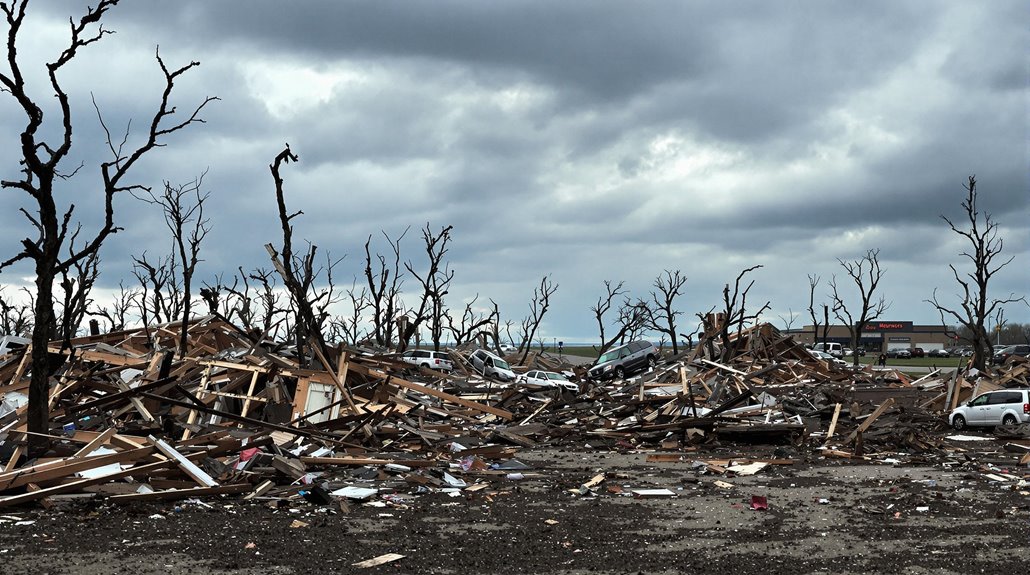
When an EF3 tornado touches down, its destructive power manifests through wind speeds ranging from 136 to 165 mph, capable of destroying well-constructed homes and severely damaging large commercial structures.
Historical data underscores the devastating impact of these storms. Between 2007 and 2017, EF3 tornadoes resulted in 265 fatalities and 3,461 injuries across the United States, with 309 confirmed occurrences during this period. The deadliest EF3 tornado struck in February 2008, claiming 22 lives across Tennessee and Kentucky.
The environmental impact is equally severe, as these tornados can completely strip bark from trees and compromise structural foundations.
Recent events highlight the critical importance of tornado preparedness. The 2024 Indian Lake, Ohio EF3 tornado, which traveled 31.2 miles, caused three fatalities and prompted a major disaster declaration.
Such incidents demonstrate the consistent damage patterns associated with EF3 tornadoes, including the destruction of framed houses, overturned trains, and extensive damage to commercial buildings.
Essential Safety Measures During an EF3 Tornado
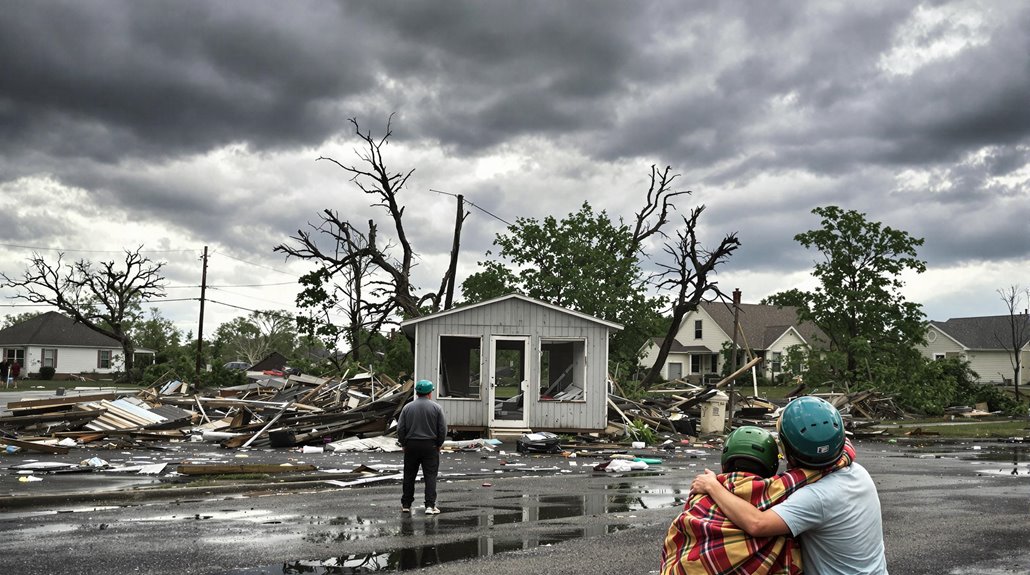
Implementing extensive safety measures stands as the critical defense against an EF3 tornado's devastating 136-165 mph winds.
Primary tornado preparedness tips emphasize seeking shelter in FEMA-certified safe rooms or ICC 500 storm shelters, which provide near-absolute protection against these violent storms.
Shelter location guidance dictates that individuals should proceed to the lowest level of a sturdy building, specifically selecting a small, interior room without windows. While in these rooms, occupants must stay away from room corners since they attract debris.
In mobile homes, immediate evacuation to pre-identified safe structures is essential, as these dwellings cannot withstand EF3-level forces.
Vehicle occupants must abandon their automobiles and seek proper shelter or, as a last resort, lie flat in a low-lying area.
Protection of the head and neck remains paramount, utilizing blankets, coats, or helmets as protective covering.
Maintaining distance from windows, exterior walls, and large objects reduces the risk of injury from wind-driven debris, while continuous monitoring of weather updates guarantees awareness of evolving conditions.
Building and Property Damage From EF3 Tornadoes
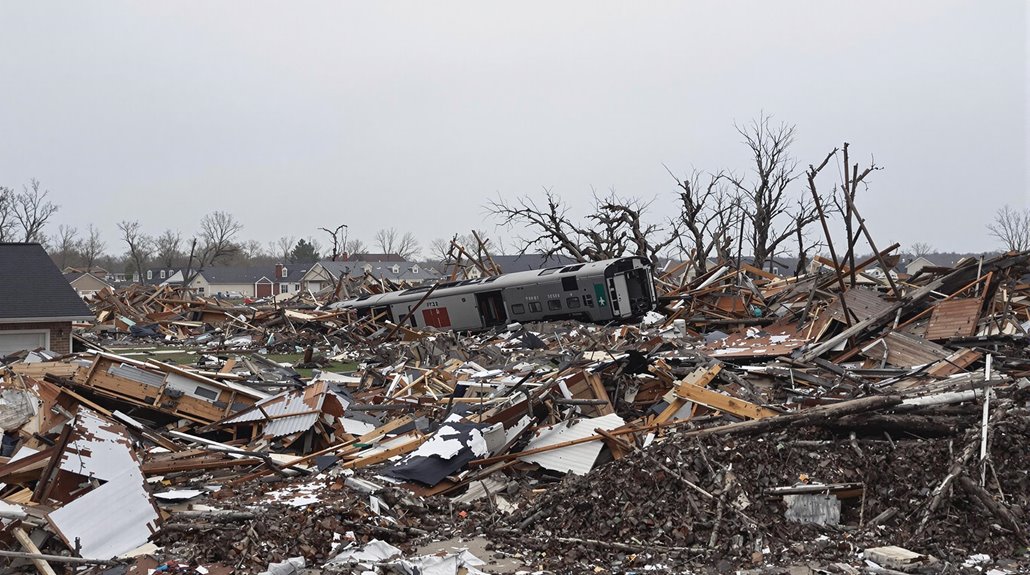
EF3 tornadoes release catastrophic forces that inflict severe structural damage, with wind speeds ranging from 136 to 165 mph (218-266 km/h).
Property assessment data reveals extensive destruction patterns across residential and commercial structures, with single-family homes often suffering complete devastation. The tornado impact typically results in collapsed walls, destroyed roofs, and compromised structural integrity. The April 25-26 outbreak impacted over 7,000 homes across multiple states.
Recent data demonstrates the significant financial toll of these storms, with property damage reaching $708 million in 2022 and exceeding $1 billion in 2023.
The April 2024 tornado outbreak alone caused an estimated $2.1 billion in home damage. Damage indicators show that EF3 tornadoes can overturn entire trains, strip bark from trees, and demolish well-constructed buildings.
Weather experts utilize 28 specific damage indicators and 12 degrees of damage to accurately classify tornado intensity, examining everything from foundation damage to the vaulting of structural units.
Notable EF3 Tornado Events and Statistics
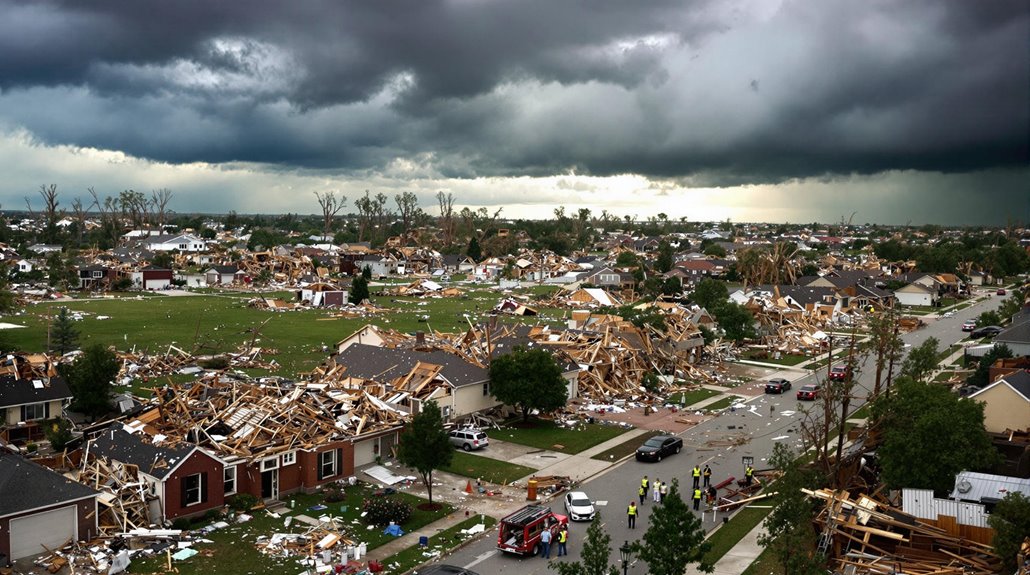
Over the past two decades, several catastrophic EF3 tornadoes have left significant impacts across the United States, with the 2008-2024 period recording multiple high-casualty events. Notable incidents include the February 2008 Tennessee-Kentucky tornado that claimed 22 lives, and the 2007 Florida event resulting in 13 fatalities, emphasizing the critical importance of tornado preparedness tips.
Statistical data from 2007-2017 reveals 309 confirmed EF3 tornadoes in the United States, causing 265 fatalities and 3,461 injuries. The year 2011 marked a peak with 69 EF3 tornadoes.
Recent activity in 2024 showed concentrated events across multiple regions, with significant outbreaks in April, May, and December. Tornado aftermath recovery efforts focused particularly on states within Tornado Alley and the Southeast, where EF3 events frequently occur.
Under the Enhanced Fujita Scale implemented in 2007, these tornadoes generate wind speeds between 136-165 mph, causing severe structural damage.
Creating an Emergency Preparedness Plan
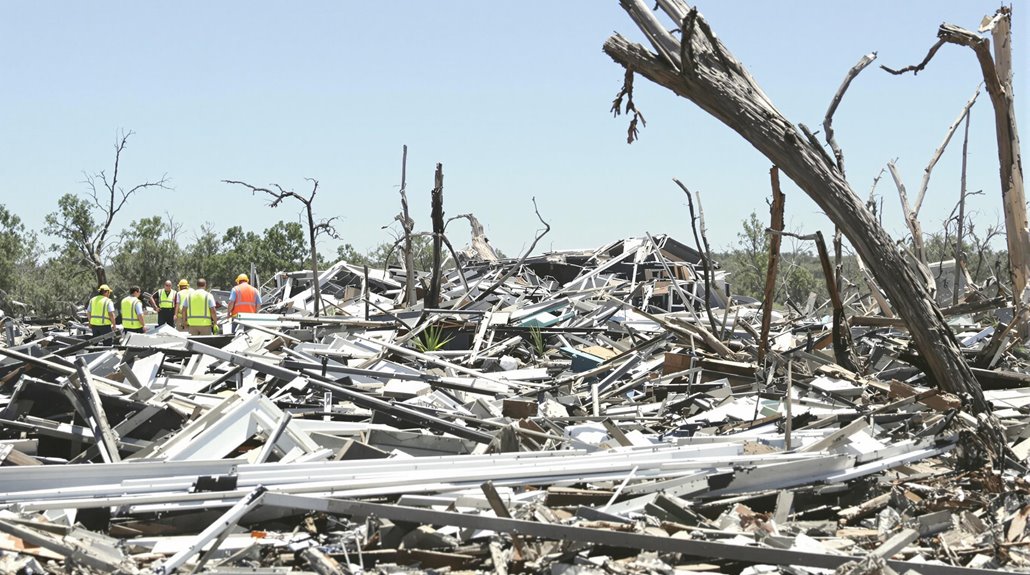
When developing a thorough emergency preparedness plan for EF3 tornadoes, facility managers must incorporate four federally mandated core elements that address risk assessment, response procedures, resource allocation, and communication protocols.
The implementation process begins with a detailed risk assessment that identifies potential vulnerabilities specific to EF3 tornadoes, which can produce winds up to 165 mph. Facility managers must then establish detailed evacuation routes and shelter-in-place procedures based on the building's structural integrity and location. Having multiple evacuation routes available helps ensure safe escape options during emergencies.
Communication plans should integrate multiple notification systems, including emergency broadcast systems, mobile alerts, and backup communications methods that comply with state and federal regulations.
Annual reviews guarantee plan effectiveness, while regular drills test response procedures and identify areas requiring improvement. Integration with local emergency management agencies and public health departments enhances coordinated response capabilities.
The plan must also specify resource allocation strategies for essential supplies, equipment, and personnel during tornado emergencies.
Weather Monitoring and Warning Systems
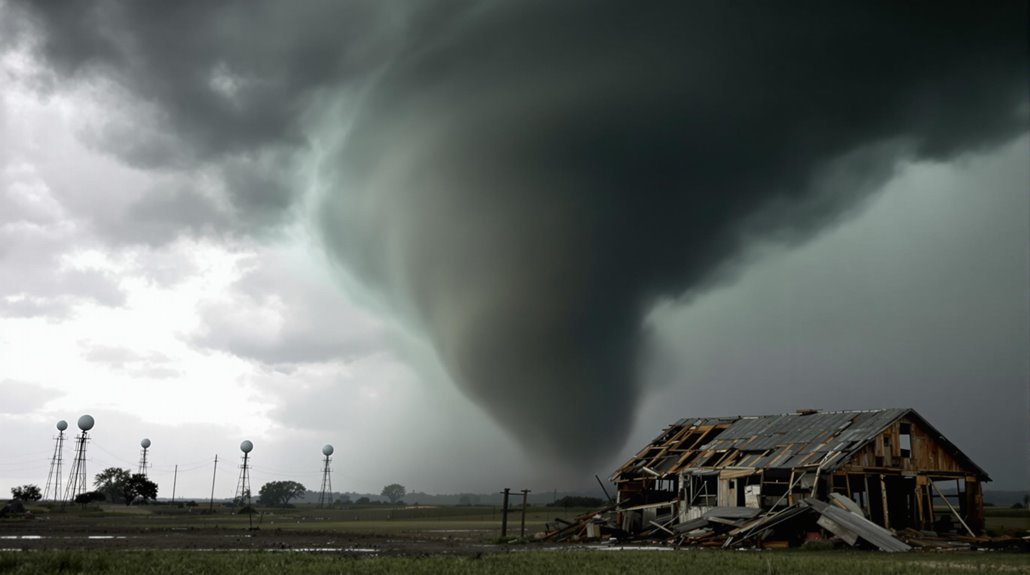
Modern tornado detection relies on a sophisticated array of monitoring systems that combine traditional Doppler radar with advanced electromagnetic sensing technologies. These tornado prediction technologies incorporate both established methods and innovative solutions, ensuring thorough severe weather monitoring.
| Detection Method | Key Features |
|---|---|
| Doppler Radar | Mesocyclone and TVS detection |
| Dual-Polarization | Ground debris identification |
| NTDA | Machine learning algorithms |
| Tornado Alert | Electromagnetic signal analysis |
| NSSL On-Demand | Web-based circulation mapping |
The Tornado Alert system represents a significant advancement in emergency communication systems, operating independently of traditional infrastructure. It detects atmospheric signals like tweaks, whistlers, and sferics within a 30-mile radius, providing essential early warnings up to 30 minutes before impact. This NASA-validated technology maintains 95% accuracy and continues functioning during power outages when conventional systems may fail, offering a reliable backbone for severe weather monitoring and community safety protocols.
Post-Tornado Recovery and Response
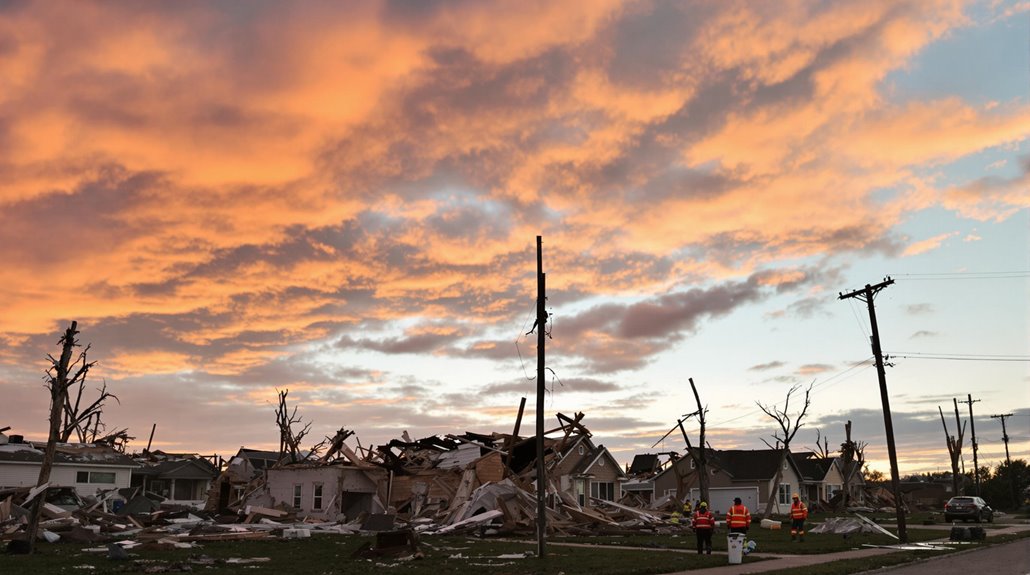
Following an EF3 tornado's impact, immediate emergency response requires systematic assessment of structural damage, hazardous conditions, and utility risks within the affected zone.
The recovery timeline typically spans 1-6 months, encompassing emergency repairs, insurance claim processing, and major structural rehabilitation work.
Long-term rebuilding strategies must account for economic impacts, which can reach billions in damages, while incorporating disaster assistance programs and mental health support for affected communities.
Immediate Emergency Response Steps
Responding effectively in the immediate aftermath of an EF3 tornado requires a systematic approach to safety and damage assessment. Initial priorities include evaluating injuries, providing first aid, and evacuating damaged structures.
Emergency supplies and flashlights should be utilized instead of candles to prevent secondary disasters. Community support networks must be activated while maintaining distance from downed power lines and compromised utilities.
A thorough damage assessment protocol follows, including structural evaluations, photographic documentation for insurance purposes, and identification of immediate hazards.
Communication channels must remain operational to coordinate with emergency services, update family members, and monitor official alerts.
Support services should be mobilized to provide essential resources, including temporary housing, behavioral health assistance, and basic necessities for affected populations.
Long-Term Rebuilding Strategies
After implementing immediate emergency responses, communities must develop systematic long-term rebuilding strategies to restore infrastructure and strengthen resilience against future EF3 tornadoes.
Strategic planning begins with a thorough master plan that prioritizes infrastructure resilience through tornado-resistant materials and enhanced structural designs.
The recovery process requires systematic debris removal, detailed structural integrity assessments, and professional restoration experts.
Community engagement remains vital, involving residents in planning decisions while supporting local business recovery.
Federal and state resources, particularly FEMA assistance and HUD-DR funds, provide indispensable financial support for reconstruction efforts.
Success depends on coordinated execution across multiple domains: structural restoration, economic revitalization, and emergency preparedness enhancement.
Regular progress monitoring guarantees rebuilding efforts align with established goals while maintaining focus on creating more resilient communities equipped to withstand future tornado events.
Seasonal Patterns and Geographic Distribution
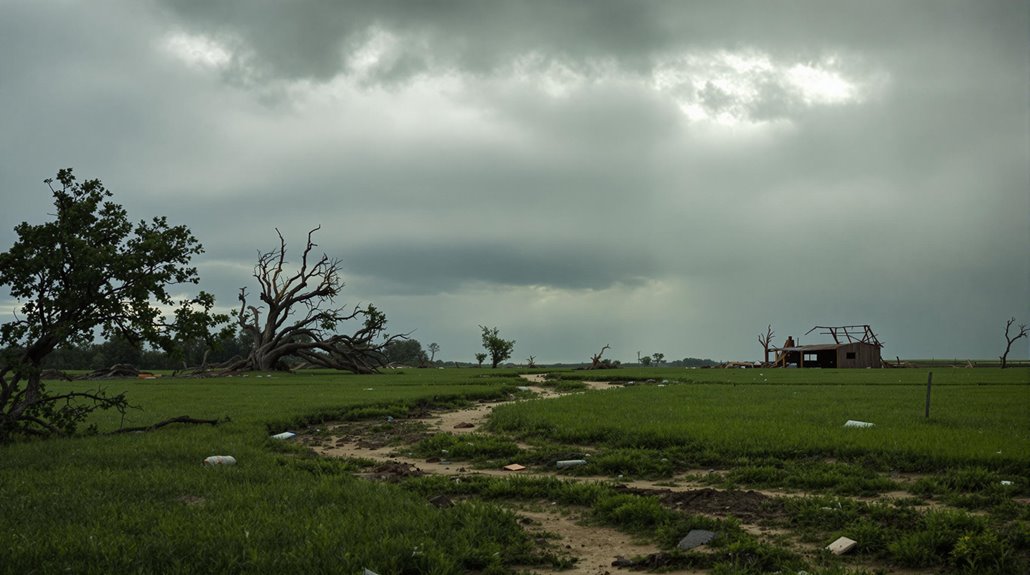
Three distinct seasonal patterns characterize EF3 tornado occurrences across North America, with spring representing the primary peak period due to the convergence of warm Gulf moisture and cold Canadian air masses.
Tornado seasonality varies considerably by region, with geographic hotspots experiencing different peak periods throughout the year.
Key regional and seasonal variations include:
- Tornado Alley experiences maximum activity between April and June
- Northern states see peak tornado formation during summer months (June-July)
- Dixie Alley encounters dual peaks in spring and late fall/early winter
- Atlantic coastal regions show heightened activity during autumn
- Far northern European countries peak in July
While spring maintains prominence for severe tornado development, particularly in the Plains and Midwest, a secondary peak emerges from late September through mid-November.
Winter months typically show reduced activity, except in southern states where warm Gulf air can still trigger considerable tornado formation when meeting Arctic air masses.
Historical Impact and Documentation Methods
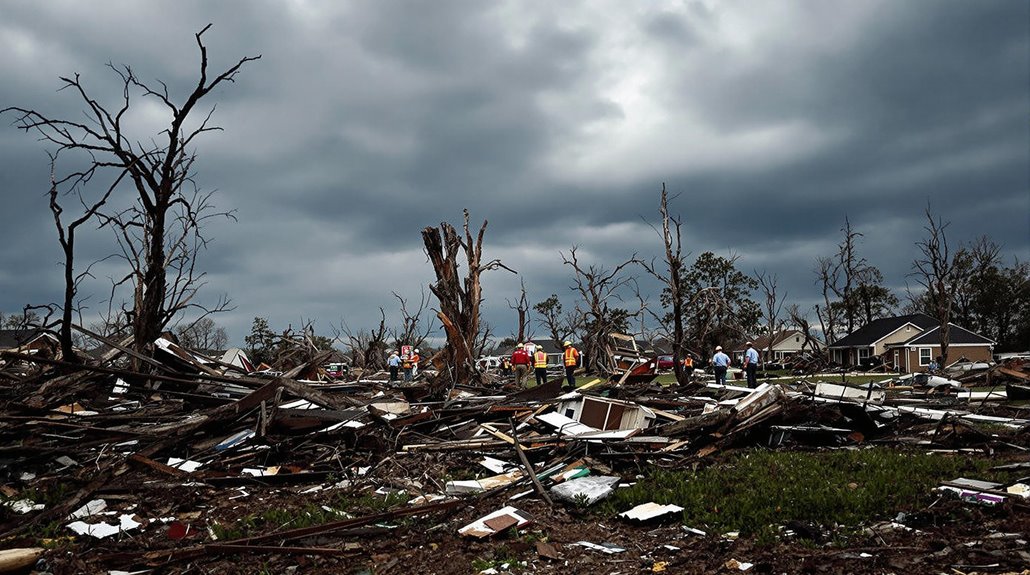
Throughout recorded history, EF3 tornadoes have demonstrated considerable destructive capacity across North America, with documented cases revealing wind speeds of 136-165 mph and widespread structural damage. Recent events underscore their devastating impact, including the 2024 Indian Lake tornado that claimed three lives and the 2007 Florida tornado that resulted in eight fatalities.
Documentation methods have evolved considerably with the implementation of the Enhanced Fujita Scale, which utilizes 28 Damage Indicators and specialized Degrees of Damage assessments. This systematic approach to historical analysis enables more precise categorization of tornado events and supports enhanced tornado preparedness initiatives.
Notable examples include the March 2022 Washington County tornado and the March 2019 Leon County event, where detailed surveys documented maximum winds of 140 mph. The extensive documentation system now requires thorough path width measurements, damage assignment protocols, and expert survey team evaluations, creating a robust database for understanding these powerful atmospheric phenomena.
The Benefits Of Consulting A Public Adjuster
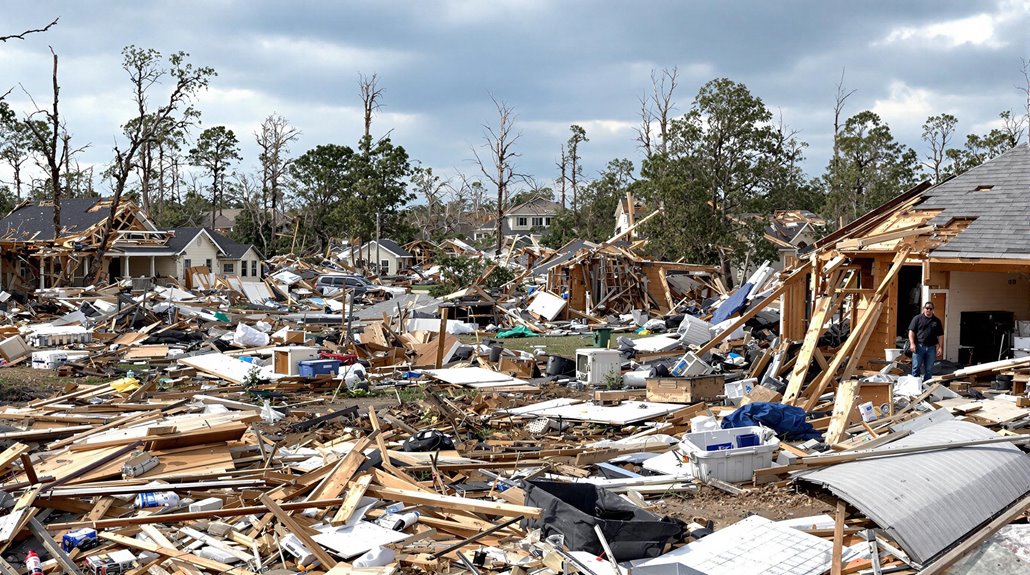
Following an EF3 tornado's devastating impact, consulting a public adjuster can greatly enhance insurance claim outcomes through their specialized expertise in policy interpretation and extensive damage assessment protocols.
Public adjusters provide objective documentation of structural damage, wind-related losses, and debris scatter patterns, ensuring all tornado-related impacts are properly cataloged and validated.
Their professional negotiation capabilities and thorough understanding of severe weather damage typically result in higher claim settlements while streamlining the complex post-tornado claims process for affected property owners.
Studies demonstrate that property owners who engage public adjuster services receive up to 500% higher settlements for non-catastrophic claims compared to those who handle claims independently.
Expertise In Insurance Claims
When facing the devastating aftermath of an EF3 tornado, consulting a public adjuster can considerably impact insurance claim outcomes, with data showing settlements up to 574% larger compared to unrepresented claims.
These licensed professionals navigate insurance policy intricacies and employ effective claims negotiation strategies to maximize settlements.
Key advantages of public adjuster expertise include:
- Extensive damage assessment, including identification of hidden structural impacts
- Expert interpretation of complex policy language and coverage limitations
- Professional documentation of all tornado-related losses and expenses
- Strategic negotiation with insurance carriers to secure maximum compensation
- Independent representation focused solely on policyholder interests
Their contingency-based payment structure aligns with claimant interests, ensuring thorough claim preparation and ideal settlement outcomes during the post-tornado recovery process.
Unlike insurance adjusters who represent company interests, public adjuster fees in states like Texas typically cap at 10% of the total claim settlement, providing transparent cost expectations for policyholders.
Objective Damage Assessment
An objective damage assessment conducted by public adjusters provides property owners with a thorough evaluation that encompasses both visible and concealed tornado damage.
These professionals employ systematic methods to document structural compromises, utilizing photographic evidence and consulting specialists to address visibility challenges in hard-to-reach areas.
The assessment process incorporates forensic accounting and building estimation expertise to quantify both immediate and long-term damage implications.
Public adjusters methodically evaluate structural integrity, cosmetic deterioration, and secondary damage patterns that may emerge post-tornado.
Their all-encompassing approach guarantees documentation of all affected components, from foundation impacts to roof system degradation.
This systematic documentation serves as essential evidence when maneuvering through insurance claims and establishing the full scope of necessary repairs and replacements.
With settlements averaging higher when public adjusters manage claims, property owners often benefit from their expertise in navigating complex tornado damage assessments.
Streamlined Claim Process
The complexities of maneuvering insurance claims after an EF3 tornado's devastation can be greatly streamlined through public adjuster consultation.
These professionals enhance claim efficiency through expert documentation, systematic assessment, and strategic negotiation tactics, ensuring maximum compensation for tornado-related damages.
- Extensive property damage evaluation and documentation protocols
- Expert interpretation of insurance policy coverage and limitations
- Strategic communication management with insurance providers
- Professional damage cost analysis and value assessment
- Advanced negotiation strategies for ideal claim settlement
Public adjusters serve as technical intermediaries, applying their specialized knowledge to expedite the claims process while policyholders focus on recovery.
Their systematic approach includes thorough documentation of structural damage, content loss assessment, and detailed cost analysis.
This methodical process, combined with their understanding of post-tornado damage patterns, greatly increases the likelihood of securing appropriate compensation for EF3 tornado devastation.
Operating on a contingency fee basis, public adjusters typically charge 5-20% of the final settlement while helping streamline the entire claims process.
Higher Claim Payouts & Settlements
Statistics consistently demonstrate that engaging a public adjuster for EF3 tornado damage claims results in notably higher settlement amounts, often 40% more than self-managed claims. These professionals employ specialized claim strategies, documenting thorough structural assessments and identifying concealed damages that property owners might overlook. Their expertise in financial recovery greatly impacts settlement outcomes.
| Impact Area | Self-Managed Claims | With Public Adjuster |
|---|---|---|
| Settlement Time | 4-6 months | 2-3 months |
| Documentation | Basic damage report | Thorough analysis |
| Hidden Damages | Often missed | Thoroughly identified |
| Average Payout | Base compensation | Up to 40% higher |
Public adjusters' objective assessments and negotiation expertise prove particularly valuable in complex EF3 tornado cases, where damage patterns can be intricate and extensive. Their contingency-based fee structure guarantees aligned interests in maximizing claim settlements. Effective communication between adjusters, contractors, and homeowners significantly enhances the likelihood of successful claims.
About The Public Claims Adjusters Network (PCAN)

Professional claims adjusters within the Public Claims Adjusters Network (PCAN) serve as specialized advocates for policyholders dealing with tornado-related insurance claims. Their expertise in the insurance claim process includes thorough damage assessment, policy interpretation, and strategic negotiation to maximize claim settlements.
Key Public Adjuster Roles include:
- Conducting detailed assessments of tornado-related structural damage
- Analyzing insurance policies to determine full coverage scope
- Documenting and filing extensive claims with insurers
- Negotiating settlements based on documented damages
- Managing all communication between policyholders and insurance companies
PCAN adjusters operate under strict regulatory standards and must maintain professional certifications. They work independently from insurance companies, focusing solely on policyholder interests.
Their services typically result in higher claim settlements while reducing the administrative burden on property owners during the post-tornado recovery period.
Frequently Asked Questions
How Long Does an EF3 Tornado Typically Stay on the Ground?
Like a stopwatch in Mother Nature's hand, tornado duration data indicates most EF3 tornadoes remain on the ground for less than 10 minutes, though damage assessment shows path lengths averaging 3-5 miles.
Can an EF3 Tornado Change Intensity During Its Path?
Tornadoes frequently exhibit intensity fluctuation during their lifecycle, strengthening or weakening as they track across terrain. A single tornado can shift between different EF ratings within minutes of formation.
What Percentage of All Tornadoes Are Classified as EF3?
Among all documented tornado classifications, EF3 tornadoes represent a relatively rare 2.18% occurrence, characterized by wind speeds of 136-165 mph and capable of inflicting severe structural damage to well-constructed buildings.
How Far Can an EF3 Tornado Throw Large Objects Like Vehicles?
EF3 tornadoes can generate sufficient wind force to cause substantial vehicle displacement, with tornado debris and heavy automobiles potentially being thrown several hundred feet from their original location.
Do EF3 Tornadoes Produce Different Sounds Than Weaker or Stronger Tornadoes?
EF3 tornadoes generate distinct tornado acoustics with specific sound frequency patterns, producing 120-150 dB levels and unique 80-100 Hz high-frequency shoulders, differentiating them from weaker or stronger tornado classifications.
References
- https://www.factsjustforkids.com/weather-facts/ef3-tornado/
- http://www.meteor.iastate.edu/~ssanteiu/PDFs/314portfolio.pdf
- https://www.worldvision.org/disaster-relief-news-stories/tornado-facts
- https://rainbowrestores.com/blog/what-is-the-fujita-scale
- https://www.jbmdl.jb.mil/Portals/47/documents/AFD-150205-027.pdf
- https://atlassaferooms.com/what-is-the-ef-scale-for-tornados/
- https://www.youtube.com/c/WCNC
- https://www.weather.gov/mkx/taw-tornado_classification_safety
- https://en.wikipedia.org/wiki/EF4
- https://www.accuweather.com/en/hurricane/hurricane-milton-by-the-numbers-an-ef3-tornado-and-blowout-tide/1702670





